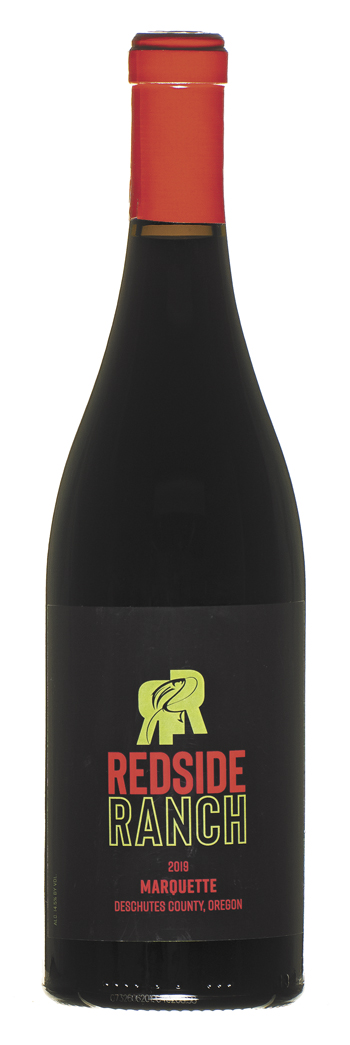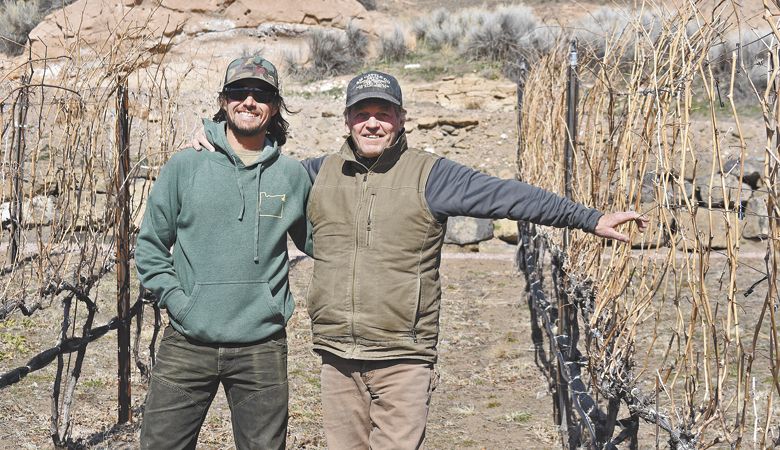Marquette Mania
Redside wins gold with Minnesota hybrid
The Marquette grape is the finest thing to come out of the University of Minnesota since Yanni. Now wine alchemists in Central Oregon are turning its juice into gold.
The 2019 Redside Ranch Marquette recently captured a gold medal at the 21st annual San Francisco Wine Competition. The category: Red Natives/Hybrid Varietals. The victory makes the case for paying more attention to the potential for cold-hardy hybrids in Oregon.
Winemaker Kirk Ermisch of the Elixir Wine Group in Bend crafted the winning wine with Marquette grapes grown at Redside Ranch Vineyard near Terrebonne. The site is managed by veteran viticulturalist Kerry Damon.
After recovering from my surprise that hybrid grapes were a category in a major wine competition, I had questions. What the heck is Marquette? What is it doing at 2,800 feet above sea level in Central Oregon? What kind of red wine does it make?
A hybrid grape variety is produced by crossing two or more Vitis species. In Marquette’s case, University of Minnesota specialists crossed MN 1094 with Ravat 262. Although the initial cross occurred in 1989, Marquette wasn’t patented and released to the public until 2006.
Drew Horton, an enology specialist in the University of Minnesota’s Grape Breeding & Enology Project, says Marquette’s genetic background includes several American native species of Vitis that aren’t exactly household names. Aestivalis or rotundifolia, anyone?

The vinifera members of Marquette’s family sound more familiar. Pinot Noir is a grandparent, and more distant relatives include Cabernet Sauvignon, Cabernet Franc and Merlot.
Marquette was created to survive temperatures down to minus 25 degrees Fahrenheit while offering excellent resistance to diseases like powdery mildew and black rot. Its mission? Survive Minnesota.
“In addition to Minnesota, people are growing Marquette in Finland and Estonia, places where you don’t even think about wine being made” Horton said. Coupled with a south-facing vineyard slope and wind protection, he says Marquette vines can even survive temperatures as low as minus 34 degrees.
Horton’s description fits Redside Ranch to a T, with its steep, south-facing hill offering wind protection. While temperatures here occasionally drop into the negative teens and 20s, these Oregon Marquette vines are doing just fine.
Redside’s five acres of own-rooted Marquette vines west of Terrebonne grow within grape seed-spitting distance of the Deschutes River. The vineyard’s alluvial soils contain loamy sand and large cobblestones left behind by glaciation and ancient rivers. If not for the vineyard, you might believe you were walking on the moon.
To increase wine production, Damon is currently drilling holes for an additional 1,000 Marquette vines. The new plantings will not only add 30 feet of elevation and 1.5 acres to the vineyard, they might just change the wine itself.
As he moves up the slope, Damon’s drill hits deposits of compressed volcanic ash, also known as welded tuff. “I’m excited to see how this volcanic character plays out in future wines. We could be looking at new territory in terms of wine complexity with this grape,” he noted
Redside Ranch is owned by Kris Kibak, an entrepreneur based in San Diego; his cousin, Ryder Redfield, manages the property. Kibak purchased the 400-acre site in January 2017 from Doug and Betty Dunn.
The Dunns had previously planted Pinot Noir, Riesling, Albariño and Marquette on the property in 2009. While the vinifera vines struggled, Marquette thrived. After Kibak purchased the land, Damon tore out the Dunns’ vinifera vines to plant more Marquette. The 2019 Redside Ranch Marquette, all 35 cases, was produced entirely with grapes from the Dunns’ original plantings.
Ermisch treated the Marquette grapes as gently as possible throughout fermentation to minimize the “gunkiness” hybrid grapes can create from their seeds and pulp. With two weeks spent on the skins, the wine rested in stainless steel until racked into new oak.
The resulting wine is like a Ralph Steadman rendering of a Willamette Valley Pinot Noir-1970s California Zinfandel wedding.
Scents and flavors of blackberries, plums and black pepper dominate initially, followed by notes of rose water, cremini mushrooms, worn saddle leather and, of all things, rhubarb. With modest tannins and a perfect touch of acidity, the liquid feels downright slippery.
How deft is Ermisch’s touch? This wine embraced new oak, yet possesses the kind of mouthfeel earned from a life in concrete. The label states 14.5% alcohol by volume, but the wine is as cool and balanced as a Wallenda. I’m definitely planning to check out his other wines at Ermisch Cellars.
Gold medals are great, but what truly counts is what is in this bottle. This wine, which tastes Oregon while feeling Minnesota, is definitely worth $35. I just hope they don’t increase the price once the welded tuff kicks in.
The Changeup, a monthly column by Michael Alberty, is a baseball pitch designed to disorient and confuse. It’s the perfect representation of the unknown and its mastery over those who think they know what to expect. This column is devoted to those unorthodox Oregon wines you never saw coming.











